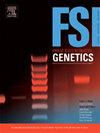单卵双胞胎在法医调查中的表观遗传分化使用纳米孔测序
IF 3.1
2区 医学
Q2 GENETICS & HEREDITY
引用次数: 0
摘要
由于同卵双胞胎具有相同的核DNA,使得传统的标记如STRs和SNPs无效,因此对法医遗传学提出了重大挑战。这一限制突出了在刑事调查、灾难受害者鉴定和亲子鉴定中区分mzt的新方法的必要性。目前的方法缺乏区分mzt的分辨率,造成了人类识别的空白。表观遗传标记,如DNA甲基化,通过反映双胞胎后的环境和随机差异提供了一个解决方案。然而,传统的测序技术往往不能满足法医对分辨率、速度或可靠性的要求。为了解决这个问题,我们使用牛津纳米孔测序分析了六个MZT对的全基因组DNA甲基化模式,确定了强大的表观遗传生物标志物,用于法医鉴定。我们的方法利用长读测序和单碱基分辨率来克服传统的限制。该研究旨在确定差异甲基化位点(dml)作为区分MZTs的稳定、可遗传的生物标志物,即使在降解或痕量样品中也是如此,同时证明纳米孔测序的法医实用性。我们发现3820个共享的dml富集于代谢和神经通路,定位于启动子(1.84 %)和基因间(88.03 %)区域。纳米孔测序实现了>; 99.5 %的比对效率和>; 13 kb N50读取长度,实现了快速,无pcr分析。这项研究表明,基于纳米孔的甲基化分析通过捕获环境影响的表观遗传差异,有效地区分MZTs,为法医鉴定提供可操作的生物标志物。通过连接表观遗传学和法医学,我们的发现提高了人类鉴定的准确性,为刑事案件工作、灾难受害者鉴定和亲子鉴定提供了变革性的工具,解决了在解决涉及基因难以区分的个体的案件方面的长期限制。本文章由计算机程序翻译,如有差异,请以英文原文为准。
Epigenetic differentiation of monozygotic twins in forensic investigations using nanopore sequencing
Monozygotic twins (MZTs) pose a significant challenge in forensic genetics due to their identical nuclear DNA, rendering conventional markers like STRs and SNPs ineffective. This limitation highlights the need for novel approaches to distinguish MZTs in criminal investigations, disaster victim identification, and paternity testing. Current methods lack the resolution to differentiate MZTs, creating a gap in human identification. Epigenetic markers, such as DNA methylation, offer a solution by reflecting environmental and stochastic differences post-twinning. However, traditional sequencing technologies often fail to meet forensic requirements for resolution, speed, or reliability. To address this, we employed Oxford Nanopore sequencing to analyze genome-wide DNA methylation patterns in six MZT pairs, identifying robust epigenetic biomarkers for forensic discrimination. Our approach leverages long-read sequencing and single-base resolution to overcome conventional limitations. The study aimed to identify differentially methylated loci (DMLs) as stable, heritable biomarkers for distinguishing MZTs, even in degraded or trace samples, while demonstrating the forensic utility of nanopore sequencing. We identified 3820 shared DMLs enriched in metabolic and neural pathways, localized to promoter (1.84 %) and intergenic (88.03 %) regions. Nanopore sequencing achieved > 99.5 % alignment efficiency and > 13 kb N50 read lengths, enabling rapid, PCR-free analysis. This study demonstrates that nanopore-based methylation profiling effectively distinguishes MZTs by capturing environmentally influenced epigenetic differences, providing actionable biomarkers for forensic discrimination. By bridging epigenetics and forensics, our findings advance precision in human identification, offering transformative tools for criminal casework, disaster victim identification, and paternity testing, addressing a longstanding limitation in resolving cases involving genetically indistinguishable individuals.
求助全文
通过发布文献求助,成功后即可免费获取论文全文。
去求助
来源期刊
CiteScore
7.50
自引率
32.30%
发文量
132
审稿时长
11.3 weeks
期刊介绍:
Forensic Science International: Genetics is the premier journal in the field of Forensic Genetics. This branch of Forensic Science can be defined as the application of genetics to human and non-human material (in the sense of a science with the purpose of studying inherited characteristics for the analysis of inter- and intra-specific variations in populations) for the resolution of legal conflicts.
The scope of the journal includes:
Forensic applications of human polymorphism.
Testing of paternity and other family relationships, immigration cases, typing of biological stains and tissues from criminal casework, identification of human remains by DNA testing methodologies.
Description of human polymorphisms of forensic interest, with special interest in DNA polymorphisms.
Autosomal DNA polymorphisms, mini- and microsatellites (or short tandem repeats, STRs), single nucleotide polymorphisms (SNPs), X and Y chromosome polymorphisms, mtDNA polymorphisms, and any other type of DNA variation with potential forensic applications.
Non-human DNA polymorphisms for crime scene investigation.
Population genetics of human polymorphisms of forensic interest.
Population data, especially from DNA polymorphisms of interest for the solution of forensic problems.
DNA typing methodologies and strategies.
Biostatistical methods in forensic genetics.
Evaluation of DNA evidence in forensic problems (such as paternity or immigration cases, criminal casework, identification), classical and new statistical approaches.
Standards in forensic genetics.
Recommendations of regulatory bodies concerning methods, markers, interpretation or strategies or proposals for procedural or technical standards.
Quality control.
Quality control and quality assurance strategies, proficiency testing for DNA typing methodologies.
Criminal DNA databases.
Technical, legal and statistical issues.
General ethical and legal issues related to forensic genetics.

 求助内容:
求助内容: 应助结果提醒方式:
应助结果提醒方式:


